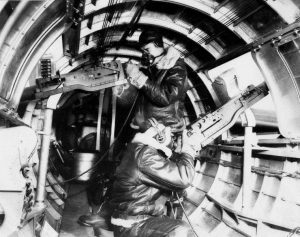19 Nov S/Sgt. Eric G. Newhouse

The B-17 waist gunners, often open to the below zero temperatures
I continue to index the MACRs (Missing Air Crew Reports) of the 306th Bomb Group Historical Association. These are the reports put together by the Air Force ground staff when a plane did not return to base. We are doing this so future historians can search for and easily find names of crew members. It’s a sobering task to read the stories of these crews.
On July 29, 1943, the 306th crews flying out of Thurleigh Airfield had orders to fly deep into Germany to the submarine building area at Kiel, Germany. It was a long haul and the crews’ third rough mission in five days. Eighteen planes left Thurleigh beginning at 0700, but by 0845, five had aborted for one reason or another. Of the 13 that reached Germany, four (i.e., forty men) did not return.
One of these planes was piloted by F/O Berryman H. Brown of the 367th bombardment squadron. At approximately 0910, just after leaving Kiel, the B-17F (#42-5766) was seen going down after losing two engines due to a fierce attack by enemy fighters.
Eight parachutes came out, and these crew members were captured and became POWs. They later reported that they had downed five German fighters before their own plane succumbed.
The survivors were: pilot Brown, copilot 2nd Lt. Ewald W. Benson, navigator 2nd Lt. Edgar P. Fergon, bombardier 2nd Lt. George J. Beyer, Jr., engineer T/Sgt. Charles A. Sheffield, radio operator Sgt. Joseph J. Thompson, waist gunner S/Sgt. Charles H. Clark, and tail gunner S/Sgt. Charles M. Roberts.
The two casualties were ball turret gunner S/Sgt. Harry W. Lofgren and waist gunner S/Sgt. Eric G. Newhouse.
In his book, First Over Germany, 306th Bomb Group historian Russell A. Strong described Newhouse as a “legendary figure of the 306th.” According to WWII historian Martin Bowman, Newhouse was born Jewish in Vienna, Austria, but was raised Catholic. His father ran a chocolate shop which was targeted by the Nazis when they took over Austria. Obviously, Hitler’s henchman only cared that the family was born Jewish.
In 1938, at the age of 15, Eric left his native country to escape Nazi persecution and arrived in the United States in March 1940 to find work as a machinist. Even before he became an American citizen he wrote the Secretary of War in Washington, DC. His letter dated July 7, 1941, reads “I want to join the United States Army and have been told that I am not eligible without special permission from the Secretary of War.”
Newhouse arrived at Thurleigh in March of 1943 and was assigned to the 367th bombardment squadron. Before much time had passed, he met a young lady and was engaged to be married. The day before his wedding was the fated mission to Kiel.
I would love to know more about Eric G. Newhouse. You can see several photographs and some of his poetry posted with the National Museum American Jewish Military History.
Again, I want to honor these young men who went through hell on July 29, 1943. I wonder if I am the last person who might record their ranks and names. Brown, Benson, Fergon, Beyer, Sheffield, Thompson, Clark, Roberts, Lofgren, and Eric. G. Newhouse. It’s been more than 74 years.
Resources:
First Over Germany by Russell Strong
National Museum American Jewish Military History
Eager Eagles: The US Eighth Air Force in Europe, 1943-43 by Martin Bowman
Clash of Eagles by Martin Bowman


No Comments